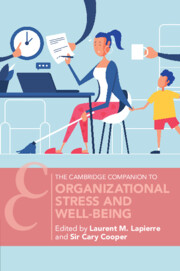Book contents
- Organizational Stress and Well-Being
- Cambridge Companions To Management
- Organizational Stress and Well-Being
- Copyright page
- Contents
- Figures
- Tables
- Contributors
- Introduction
- Part I Historical Evolution and Continued Relevance of the Study of Organizational Stress and Well-Being
- Part II Line Managers
- Part III Major Issues Relating to Stress and Well-Being
- 6 Work–Nonwork Balance and Employee Well-Being
- 7 Understanding the Decision-Making Process for Presenteeism Behavior
- 8 Burnout
- 9 Work Engagement and Organizational Well-Being
- 10 How and Why Gender Relates to Workplace Stress and Well-Being
- 11 The Measurement of Well-Being at Work
- Part IV Workplace Interventions Addressing Stress and Well-Being
- Part V Emerging Issues
- Subject Index
- References
7 - Understanding the Decision-Making Process for Presenteeism Behavior
An Integration and Conceptual Model
from Part III - Major Issues Relating to Stress and Well-Being
Published online by Cambridge University Press: 23 February 2023
- Organizational Stress and Well-Being
- Cambridge Companions To Management
- Organizational Stress and Well-Being
- Copyright page
- Contents
- Figures
- Tables
- Contributors
- Introduction
- Part I Historical Evolution and Continued Relevance of the Study of Organizational Stress and Well-Being
- Part II Line Managers
- Part III Major Issues Relating to Stress and Well-Being
- 6 Work–Nonwork Balance and Employee Well-Being
- 7 Understanding the Decision-Making Process for Presenteeism Behavior
- 8 Burnout
- 9 Work Engagement and Organizational Well-Being
- 10 How and Why Gender Relates to Workplace Stress and Well-Being
- 11 The Measurement of Well-Being at Work
- Part IV Workplace Interventions Addressing Stress and Well-Being
- Part V Emerging Issues
- Subject Index
- References
Summary
Although of potentially great value for supporting employees in balancing health and performance, our current understanding of how individuals make decisions to attend or not to attend work when they are experiencing ill-health is non-existent. We have a comprehensive understanding of the range of factors that may impact on presenteeism behavior, but that stops short at the decision-making process that takes place before presenteeism is enacted. In this chapter, we propose a model of presenteeism decision-making, which encapsulates both absenteeism and presenteeism as potential outcomes of the same decision process. Building on the literatures relating to decision-making, sickness presenteeism, health behavior, and organizational behavior, we outline the key decision-making principles and steps that can shape presenteeism decisions and thus presenteeism behavior. This model offers the basis for understanding what interventions may be appropriate to help optimize attendance decisions, support functional presenteeism, and more effectively support employee health and productivity.
- Type
- Chapter
- Information
- Organizational Stress and Well-Being , pp. 185 - 213Publisher: Cambridge University PressPrint publication year: 2023
References
- 2
- Cited by



